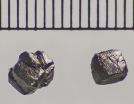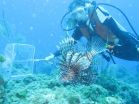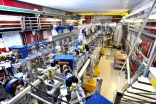(Press-News.org) Scientists have argued for half a century about the existence of a form of diamond called lonsdaleite, which is associated with impacts by meteorites and asteroids. A group of scientists based mostly at Arizona State University now show that what has been called lonsdaleite is in fact a structurally disordered form of ordinary diamond.
The scientists' report is published in Nature Communications, Nov. 20, by Péter Németh, a former ASU visiting researcher (now with the Research Centre of Natural Sciences of the Hungarian Academy of Sciences), together with ASU's Laurence Garvie, Toshihiro Aoki and Peter Buseck, plus Natalia Dubrovinskaia and Leonid Dubrovinsky from the University of Bayreuth in Germany. Buseck and Garvie are with ASU's School of Earth and Space Exploration, while Aoki is with ASU's LeRoy Eyring Center for Solid State Science.
"So-called lonsdaleite is actually the long-familiar cubic form of diamond, but it's full of defects," says Péter Németh. These can occur, he explains, due to shock metamorphism, plastic deformation or unequilibrated crystal growth.
The lonsdaleite story began almost 50 years ago. Scientists reported that a large meteorite, called Canyon Diablo after the crater it formed on impact in northern Arizona, contained a new form of diamond with a hexagonal structure. They described it as an impact-related mineral and called it lonsdaleite, after Dame Kathleen Lonsdale, a famous crystallographer.
Since then, "lonsdaleite" has been widely used by scientists as an indicator of ancient asteroidal impacts on Earth, including those linked to mass extinctions. In addition, it has been thought to have mechanical properties superior to ordinary diamond, giving it high potential industrial significance. All this focused much interest on the mineral, although pure crystals of it, even tiny ones, have never been found or synthesized. That posed a long-standing puzzle.
The ASU scientists approached the question by re-examining Canyon Diablo diamonds and investigating laboratory samples prepared under conditions in which lonsdaleite has been reported.
Using the advanced electron microscopes in ASU's Center for Solid State Science, the team discovered, both in the Canyon Diablo and the synthetic samples, new types of diamond twins and nanometer-scale structural complexity. These give rise to features attributed to lonsdaleite.
"Most crystals have regular repeating structures, much like the bricks in a well-built wall," says Peter Buseck. However, interruptions can occur in the regularity, and these are called defects. "Defects are intermixed with the normal diamond structure, just as if the wall had an occasional half-brick or longer brick or row of bricks that's slightly displaced to one side or another."
The outcome of the new work is that so-called lonsdaleite is the same as the regular cubic form of diamond, but it has been subjected to shock or pressure that caused defects within the crystal structure.
One consequence of the new work is that many scientific studies based on the presumption that lonsdaleite is a separate type of diamond need to be re-examined. The study implies that both shock and static compression can produce an intensely defective diamond structure.
The new discovery also suggests that the observed structural complexity of the Canyon Diablo diamond results in interesting mechanical properties. It could be a candidate for a product with exceptional hardness.
INFORMATION:
The School of Earth and Space Exploration is an academic unit of ASU's College of Liberal Arts and Sciences.
CORVALLIS, Ore. - If you live in lionfish territory in the Atlantic Ocean, the last thing you want to be is a small fish with a long, skinny body, resting by yourself at night, near the bottom of the seafloor.
If so, your chances of being gobbled up by a lionfish increase by about 200 times.
Findings of a study on lionfish predation behavior, which may also apply to some other fish and animal species, have shed some new light on which types of fish are most likely to face attack by this invasive predator, which has disrupted ecosystems in much of the Caribbean Sea and ...
Philadelphia, PA, November 24, 2014 - Pregnant women with diabetes are at an increased risk for many adverse birth outcomes. Preconception care (PCC) can significantly lower these risks by helping pregnant mothers with diabetes control their glucose levels, resulting in healthier babies and less money spent on complicated deliveries and lifelong medical complications. Effective, universal PCC for diabetic mothers could avert an estimated $5.5 billion in health expenditures and lost employment productivity over affected children's lifetimes, according to a new study published ...
This news release is available in German.
X-ray flashes are a unique scientific tool. They are generated by accelerating electrons to very high energy levels in kilometer-long vacuum tubes, so-called linear accelerators, and then deflecting them with specially arranged magnets. In the process the particles emit X-ray radiation that is amplified until an ultra-short and intensive X-ray flash is released.
Researchers use these X-ray flashes to resolve structures as small as one ten billionth of a meter (0.1 nanometer) in size. That is roughly the diameter of a ...
LA JOLLA, CA--November 24, 2014--A team led by scientists from The Scripps Research Institute (TSRI) has found a simple method to convert human skin cells into the specialized neurons that detect pain, itch, touch and other bodily sensations. These neurons are also affected by spinal cord injury and involved in Friedreich's ataxia, a devastating and currently incurable neurodegenerative disease that largely strikes children.
The discovery allows this broad class of human neurons and their sensory mechanisms to be studied relatively easily in the laboratory. The "induced ...
ANN ARBOR--Our bones are smart. Bones know that by adolescence it's time to stop growing longer and stronger, and from that point on bones keep their shape by healing injuries.
This question of why bones grow longer and stronger in children, but stay static in adults--yet retain the ability to heal themselves, has long perplexed scientists in the bone regeneration field. But researchers from the University of Michigan, Kyoto University and Harvard University believe they may have unearthed a big piece of this puzzle.
The team discovered that a certain subset of cartilage-making ...
VIDEO:
When zebrafish are infected with bright blue Mycobacterium marinum, bright red immune cells quickly surround the bacteria to form tightly organized nuggets called granulomas (vessels green, bacteria blue, immune cells...
Click here for more information.
DURHAM, N.C. -- The body responds to tuberculosis infection by locking the bacterial offenders into tiny clusters of immune cells called granulomas, which are a hallmark of the disease. This containment strategy succeeds ...
The structure of pores found in cell nuclei has been uncovered by a UCL-led team of scientists, revealing how they selectively block certain molecules from entering, protecting genetic material and normal cell functions. The discovery could lead to the development of new drugs against viruses that target the cell nucleus and new ways of delivering gene therapies, say the scientists behind the study.
At the heart of every cell in our body is a cell nucleus, a dense structure that contains our DNA. For a cell to function normally, it needs to surround its nucleus with a ...
The first detailed, high-resolution 3-D maps of Antarctic sea ice have been developed using an underwater robot. Scientists from the UK, USA and Australia say the new technology provides accurate ice thickness measurements from areas that were previously too difficult to access.
The results, published this week in the journal Nature Geoscience (Monday 24 November 2014), step up the pace of research in the polar regions aimed at understanding the dramatic sea ice changes in the context of climate change.
Scientists use a range of technologies and techniques to measure ...
Scientists have discovered a gene that protects people against one of the major causes of stroke in young and middle-aged adults and could hold the key to new treatments.
Researchers from Royal Holloway, University of London, together with an international team from across the United States and Europe, have found that people with a specific variant of a gene, known as PHACTR1, are at reduced risk of suffering cervical artery dissection, which is caused by a tear in an artery that leads to the brain.
The new discovery, published in the journal Nature Genetics, could ...
Scientists at the Helmholtz-Zentrum Dresden-Rossendorf (HZDR) have studied the dynamics of electrons from the "wonder material" graphene in a magnetic field for the first time. This led to the discovery of a seemingly paradoxical phenomenon in the material. Its understanding could make a new type of laser possible in the future. Together with researchers from Berlin, France, the Czech Republic and the United States, the scientists precisely described their observations in a model and have now published their findings in the scientific journal Nature Physics.
Graphene ...








